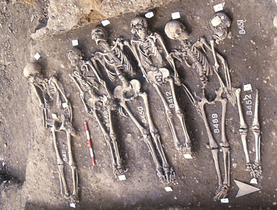
IRIS login | Reed College home Volume 96, No. 2: June 2017
Skeletons and Syphilis
Many years ago, when I was a psych major hunting for a thesis topic, I ran across a slender volume in the Reed library. It concerned an obscure neurological disorder known as general paralysis, quite common in the late nineteenth century, particularly among old mariners. The disease typically began with delusions of grandeur; as it progressed, sufferers were afflicted by a peculiar stammer, and they started to walk funny. Ultimately they lapsed into paralysis, dementia, and death.
Interesting stuff, but not really what I was looking for, so I shelved the book, promptly forgetting its title and author. One thing I did remember was the surprising conclusion that the disease had nothing to do with salt water or sea biscuit. It was, in fact, late-stage neurosyphilis, presumably acquired in dockside brothels.
After working for several years as a medical reporter, I developed an interest in the history of medicine, particularly mental and neurological disorders. So I was delighted to learn about the groundbreaking work of geneticist Kristin Harper '02, who just published a paper on the origins of syphilis.
The question of where the Great Pox came from--and who gave it to whom--has puzzled historians for centuries. Syphilis was first reported in 1495, when it raged through the army of Charles VIII of France as he retreated from an ill-advised invasion of Italy. The French called it the Italian disease, the Italians the French disease. But what was the ultimate source of the outbreak? Its suspicious timing has long fed the conjecture that syphilis was a New World disease brought to Europe by Columbus and his crew, in a sort of cosmic payback for the measles and smallpox he gave to America.
There are several reasons why this is plausible. Medieval doctors are unanimous in stating that syphilis was a new malady. There is evidence that some of Columbus's crewmen showed symptoms on the journey home. In addition, after the voyage, some crewmen are believed to have sailed to Naples, which is where Charles VIII and his army most likely acquired the pox.
The Columbian hypothesis has come under attack in recent decades, however, with reports of Old World skeletons bearing telltale marks of syphilitic infection that appear to have been buried before 1493. In particular, signs of syphilis were reported in the bones of English monks who were buried in an Augustinian friary in Hull decades before Columbus was born--a fatal blow to the theory.
Or so it seemed. In December, however, Kristin and colleagues from Emory University published a paper taking a closer look at the skeletal evidence. Radiocarbon dating, it turns out, is highly dependent on the amount of fish in the diet of the skeleton's erstwhile inhabitant; moreover, other diseases can also lead to the bone-scarring observed in syphilis.
After setting up rigorous criteria both for diagnosing syphilis and for establishing the date of the bones, Kristin and her colleagues reviewed 54 published reports and could not find a single Old World skeleton that was both clearly pre-Columbian and clearly syphilitic. The English monks? Pox-ridden sinners, to be sure. But once Kristin adjusted the radiocarbon dates for the fish in their diet, it looks like the monks may have been buried much later than originally thought, perhaps as late as 1611-- plenty of time to have caught syphilis from Columbus.
By contrast, Kristin's team found several skeletons matching these criteria from the New World, where there is overwhelming evidence of syphilis in multiple populations going back thousands of years.
This research builds on a groundbreaking paper from 2008 in which Kristin used genetic analysis to build a family tree of syphilis and several related illnesses, which are all caused by spirochetes, a sinister kind of bacteria shaped like a corkscrew. That analysis showed that syphilis is genetically most similar to a disease called yaws found in remote areas of Guyana, lending further weight to the hypothesis that syphilis originated in the New World.
Tags: alumni, neurology, strange diseases



LATEST COMMENTS
steve-jobs-1976 I knew Steve Jobs when he was on the second floor of Quincy. (Fall...
Utnapishtim - 2 weeks ago
Prof. Mason Drukman [political science 1964–70] This is gold, pure gold. God bless, Prof. Drukman.
puredog - 1 month ago
virginia-davis-1965 Such a good friend & compatriot in the day of Satyricon...
czarchasm - 4 months ago
John Peara Baba 1990 John died of a broken heart from losing his mom and then his...
kodachrome - 7 months ago
Carol Sawyer 1962 Who wrote this obit? I'm writing something about Carol Sawyer...
MsLaurie Pepper - 8 months ago
William W. Wissman MAT 1969 ...and THREE sisters. Sabra, the oldest, Mary, the middle, and...
riclf - 10 months ago